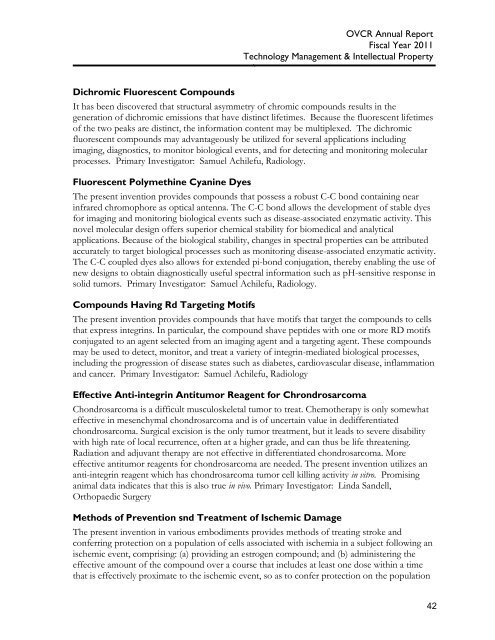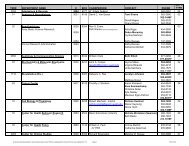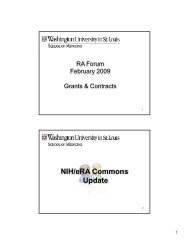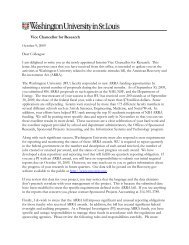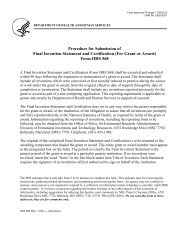A Letter from The Office of the Vice Chancellor for Research
A Letter from The Office of the Vice Chancellor for Research
A Letter from The Office of the Vice Chancellor for Research
You also want an ePaper? Increase the reach of your titles
YUMPU automatically turns print PDFs into web optimized ePapers that Google loves.
OVCR Annual ReportFiscal Year 2011Technology Management & Intellectual PropertyDichromic Fluorescent CompoundsIt has been discovered that structural asymmetry <strong>of</strong> chromic compounds results in <strong>the</strong>generation <strong>of</strong> dichromic emissions that have distinct lifetimes. Because <strong>the</strong> fluorescent lifetimes<strong>of</strong> <strong>the</strong> two peaks are distinct, <strong>the</strong> in<strong>for</strong>mation content may be multiplexed. <strong>The</strong> dichromicfluorescent compounds may advantageously be utilized <strong>for</strong> several applications includingimaging, diagnostics, to monitor biological events, and <strong>for</strong> detecting and monitoring molecularprocesses. Primary Investigator: Samuel Achilefu, Radiology.Fluorescent Polymethine Cyanine Dyes<strong>The</strong> present invention provides compounds that possess a robust C-C bond containing nearinfrared chromophore as optical antenna. <strong>The</strong> C-C bond allows <strong>the</strong> development <strong>of</strong> stable dyes<strong>for</strong> imaging and monitoring biological events such as disease-associated enzymatic activity. Thisnovel molecular design <strong>of</strong>fers superior chemical stability <strong>for</strong> biomedical and analyticalapplications. Because <strong>of</strong> <strong>the</strong> biological stability, changes in spectral properties can be attributedaccurately to target biological processes such as monitoring disease-associated enzymatic activity.<strong>The</strong> C-C coupled dyes also allows <strong>for</strong> extended pi-bond conjugation, <strong>the</strong>reby enabling <strong>the</strong> use <strong>of</strong>new designs to obtain diagnostically useful spectral in<strong>for</strong>mation such as pH-sensitive response insolid tumors. Primary Investigator: Samuel Achilefu, Radiology.Compounds Having Rd Targeting Motifs<strong>The</strong> present invention provides compounds that have motifs that target <strong>the</strong> compounds to cellsthat express integrins. In particular, <strong>the</strong> compound shave peptides with one or more RD motifsconjugated to an agent selected <strong>from</strong> an imaging agent and a targeting agent. <strong>The</strong>se compoundsmay be used to detect, monitor, and treat a variety <strong>of</strong> integrin-mediated biological processes,including <strong>the</strong> progression <strong>of</strong> disease states such as diabetes, cardiovascular disease, inflammationand cancer. Primary Investigator: Samuel Achilefu, RadiologyEffective Anti-integrin Antitumor Reagent <strong>for</strong> ChrondrosarcomaChondrosarcoma is a difficult musculoskeletal tumor to treat. Chemo<strong>the</strong>rapy is only somewhateffective in mesenchymal chondrosarcoma and is <strong>of</strong> uncertain value in dedifferentiatedchondrosarcoma. Surgical excision is <strong>the</strong> only tumor treatment, but it leads to severe disabilitywith high rate <strong>of</strong> local recurrence, <strong>of</strong>ten at a higher grade, and can thus be life threatening.Radiation and adjuvant <strong>the</strong>rapy are not effective in differentiated chondrosarcoma. Moreeffective antitumor reagents <strong>for</strong> chondrosarcoma are needed. <strong>The</strong> present invention utilizes ananti-integrin reagent which has chondrosarcoma tumor cell killing activity in vitro. Promisinganimal data indicates that this is also true in vivo. Primary Investigator: Linda Sandell,Orthopaedic SurgeryMethods <strong>of</strong> Prevention snd Treatment <strong>of</strong> Ischemic Damage<strong>The</strong> present invention in various embodiments provides methods <strong>of</strong> treating stroke andconferring protection on a population <strong>of</strong> cells associated with ischemia in a subject following anischemic event, comprising: (a) providing an estrogen compound; and (b) administering <strong>the</strong>effective amount <strong>of</strong> <strong>the</strong> compound over a course that includes at least one dose within a timethat is effectively proximate to <strong>the</strong> ischemic event, so as to confer protection on <strong>the</strong> population42


